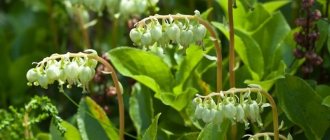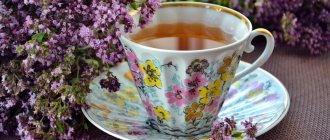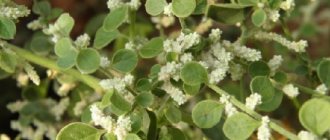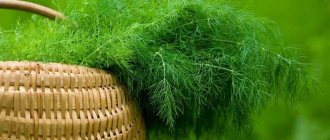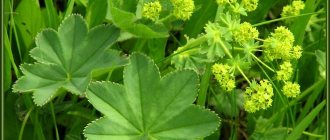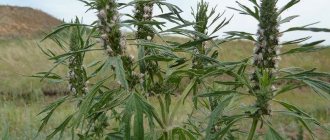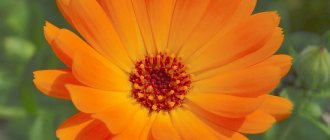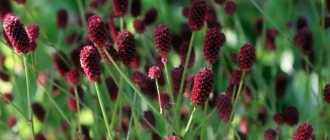When it comes to proper and healthy food, vegetables and fruits are usually the first to come to mind. And few people remember medicinal herbs and spices in this regard. And they, by the way, also play a vital role in health. Take sage, for example. This is not just a fragrant seasoning for meat or delicious tea. The benefits of this plant were known in ancient times, but today they are forgotten by many.
general characteristics
The Latin name for sage translates to “stay healthy.” And this is no coincidence. Since ancient times, this plant has been used by herbalists and traditional healers to treat a wide variety of ailments.
Content:
- general characteristics
- History of origin and use
- Chemical composition and nutritional characteristics
- Beneficial features
- Use in folk medicine
- Application in cosmetology
- Use in cooking
- How to select and store
This is a spicy herb from the mint family. Its closest relatives are oregano, lavender, rosemary, thyme, and basil. Sage is recognized by its gray-green leaves and, during its flowering period in August, by its purple-white or white-pink flowers. But unlike many herbs, this plant has a pronounced smell not only of flowers, but also of leaves. This plant has a specific aroma, vaguely reminiscent of mint, but with bitter notes.
The amazing beneficial properties of sage have made it one of the main medicinal herbs in European and Chinese herbal medicine. This plant is common in many regions, but the most famous traditional “location” is the countries around the Mediterranean Sea. By the way, there are more than 900 species of sage in the world, but not all of them are eaten.
Harm
An incorrectly selected dosage or use of a plant-based medicine for a long time (more than 3 months) can provoke an overdose, resulting in:
- surges in blood pressure;
- loss of appetite;
- decreased performance, the appearance of lethargy, weakness;
- the appearance of hallucinations;
- development of epilepsy attacks;
- frequent headaches;
- the appearance of skin rashes.
An allergic reaction to sage can manifest itself after the first dose of the medicine in the form of dizziness, nausea, vomiting, and general weakness. If symptoms are severe and there is a risk of developing anaphylactic shock, it is necessary to take an antihistamine and seek qualified medical help.
History of origin and use
Sage is native to Mediterranean countries and has been used in these regions for thousands of years. In addition, this herb has one of the longest history of use in medicine. The ancient Greeks and Romans highly valued the healing properties of sage. The Romans treated it as a sacred plant and even created a special ceremony around the collection of the herb. These cultures also used sage as a meat preservative. Ancient cooks believed that this herb slowed down the spoilage of food. And now this fact has received scientific confirmation. Researchers have found a large number of terpenes in sage, which, in fact, work as preservatives.
In addition, throughout history, sage has enjoyed the fame of a magical plant. Arab doctors in the 10th century considered it a plant of immortality; Europeans in the 14th century used the herb to protect against witchcraft. The Chinese also valued this plant. But in the east, sage was used primarily as a delicious tea.
Discovery of culture
The Mediterranean countries are considered the birthplace of the medicinal herb, where it is found in the wild. Dating back to the times of Ancient Greece and Rome, sage was used as a base for preparing medicines. The plant has found use as an excellent preservative due to its high terpene content.
The spread of sage beyond the Mediterranean helped it gain additional fame: in Arab countries it became known among doctors as the herb of immortality, in Europe as a means of protection against otherworldly forces, in China as the basis for making tonic tea.
Chemical composition and nutritional characteristics
Since this herb is generally not consumed in large quantities, it is difficult to consider it as a source of calories, carbohydrates, fat, protein or fiber. But sage can serve as a good source of other equally beneficial substances for the body.
This herb contains many essential oils, flavonoids, and phenolic compounds.
In total, these are more than 20 useful components, most of which have antioxidant properties. Sage is known for its amazing combination of essential oils containing ketane, alpha and beta thujone. Compounds such as cineole, borneol, chlorogenic, fumaric, caffeic and nicotinic acids were also found in the greenery of the plant. Nutritional value per 100 g of dry herb
| Calorie content | 315 kcal |
| Carbohydrates | 60.73 g |
| Squirrels | 10.63 g |
| Fats | 12.75 g |
| Cellulose | 40.3 g |
| Vitamin B1 | 0.754 mg |
| Vitamin B2 | 0.336 mg |
| Vitamin B3 | 5.72 mg |
| Vitamin B5 | 2.69 mg |
| Vitamin B9 | 274 mcg |
| Vitamin A | 3.5 mg |
| Vitamin C | 32.4 mg |
| Vitamin E | 7.48 mg |
| Vitamin K | 1.71 mg |
| Sodium | 11 mg |
| Potassium | 1070 mg |
| Calcium | 1652 mg |
| Copper | 0.757 mg |
| Iron | 28.12 mg |
| Magnesium | 428 mg |
| Manganese | 3.133 mg |
| Zinc | 4.7 mg |
What does salvia officinalis look like?
In order to understand what sage looks like, we suggest that you familiarize yourself with the botanical description of the plant. It has a woody, highly branched rhizome. In depth, the root system is densely fibrous. Look what the sage plant looks like in the photo.
Sage stems reach a height of 20 to 70 cm. The shoots of the plant are erect, tetrahedral, highly branched. The lower part of the stems is woody, the upper part is herbaceous.
Sage leaves are opposite, oblong, rounded or wedge-shaped, and have a gray-green color. The length of the leaf plate is from 3.5 to 8 cm, width is from 0.8 to 1.5 cm. The middle and lower stem leaves are petiolate, the upper ones are sessile. They are covered with small white hairs.
The branched inflorescences of sage consist of ten-flowered whorls. Sage flowers bloom from June to July. During this period, the plant is used for the production of bee products. Honey sage produces from 250 to 300 kg of honey per hectare.
The fruits are small round nuts, 2.5 mm in diameter. The seeds are dark brown in color and tetrahedral in shape. Sage bears fruit from August to September.
You learned what salvia officinalis looks like in the photo and a description of the plant when it blooms and bears fruit. Now let's tell you where the grass grows.
Beneficial features
Sage has a long history of medicinal use. This herb is used to treat a wide variety of disorders, including mental disorders and disorders of the digestive organs. Some of the many beneficial properties have already found their scientific confirmation, others still remain exclusively traditional medicine recipes.
The first thing you need to know about sage: this herb has a pronounced antioxidant ability. It helps protect cells from the effects of free radicals.
Antioxidant and anti-inflammatory agent
Rosmarinic acid contained in sage is easily absorbed by the body from the gastrointestinal tract. Once in the body, it reduces inflammatory reactions. In addition, rosmarinic acid acts on the body as an antioxidant. Therefore, consuming sage as a seasoning is beneficial for people with a variety of inflammatory conditions, including rheumatoid arthritis and gum disease. The effectiveness of the herb for bronchial asthma and atherosclerosis has also been proven.
By the way, the antioxidant abilities of sage have not gone unnoticed by chefs. They add herb leaves to oils to extend their shelf life and avoid rancidity.
Improves brain function
If you want to improve your memory, then add a little sage to your favorite soups, stews or casseroles. Research conducted in 2003 confirmed what traditional herbalists have known for a long time: sage is an excellent memory booster.
British researchers have confirmed that sage extract improves cognitive abilities, and medicines containing the dried root of the herb are beneficial for Alzheimer's disease. Even in ancient China, this plant was used to treat cerebrovascular diseases.
Reduces glucose and cholesterol levels
For 3 months, 40 experimental participants received sage leaf extract daily. At the end of the time allotted for the experiment, it turned out that everyone’s levels of total and “bad” cholesterol had significantly decreased, and the levels of glucose in the blood taken for analysis on an empty stomach also noticeably dropped. Another study involved 80 people diagnosed with type 2 diabetes. Compared to the control group, glucose levels significantly decreased in the experimental participants while consuming sage.
Researchers have concluded that sage leaves may be beneficial in preventing type 2 diabetes, as well as reducing the lipid profile in the body.
Eliminates excessive sweating
Scientific research conducted by German scientists has proven the effectiveness of sage in the fight against excessive sweating. The experiment showed that taking an extract of this herb helps reduce sweating activity by almost 2 times. In addition, this product eliminates unpleasant body odor.
Improves the functioning of the digestive system
Sage is useful for treating certain gastrointestinal disorders and dispersion. Tea made from this herb is an excellent carminative. The plant extract relieves symptoms of indigestion, stimulates the secretion of digestive enzymes, improves intestinal motility and pancreatic function.
Benefits of herbs
The benefits of sage for the human body are expressed in the ability to combat cosmetic imperfections and provide the necessary resources to combat diseases of internal organs. Since ancient times, the plant has been actively used in medicine due to its ability to:
- activate the process of tissue regeneration;
- normalize blood circulation and restore the natural chemical composition of the blood;
- suppress the activity of pathogenic microflora, stop inflammatory processes;
- relieve pain, relieve swelling from injuries;
- improve metabolism;
- restore the functioning of the nervous system, have a stimulating effect on the functioning of the brain;
- normalize the functioning of the digestive system;
- control the functioning of the glands, which allows you to maintain a healthy level of sex hormones and prevent an increase in the concentration of glucose in the blood;
- remove toxins and excess fluid;
- fight mucus in the lungs;
- strengthen the immune system.
Cell restoration
Regeneration processes are activated by accelerating metabolism, obtaining microelements and vitamins necessary for “construction” from the outside. Sage helps quickly heal wounds, prevent inflammation, relieve pain and itching from burns.
Acceleration of metabolism
Removing toxins, eliminating problems in the digestive system and improving blood circulation contribute to the timely delivery of necessary nutrients to every cell. As a result, overall tone and performance increase.
Reduced blood sugar levels
For the human body, sage is a natural regulator of the functioning of the glands. With the right dosage, the herb activates insulin production.
Strengthening the immune system
The complex effect on the nervous, digestive and circulatory systems allows the body to get rid of provoking factors and restore gaps in natural defenses.
Vasodilation
Eliminating the deficiency of essential vitamins and minerals helps strengthen the walls of blood vessels. Changing the biochemical composition of the blood helps prevent stagnation. Tonic components dilate blood vessels and improve blood circulation.
Anti-inflammatory effect
The antioxidants included in the composition help quickly relieve symptoms of intoxication and increase local immunity. The antiseptic effect of the herb helps suppress the activity of bacterial, viral and fungal infections that cause inflammation.
Preventing cell mutation
The plant effectively reduces the activity of cancer cell division during the formation of tumors of the skin, mammary glands, oral cavity and reproductive system.
Use in folk medicine
This medicinal plant was known to the ancient Egyptians. Long-standing records indicate that the pyramid builders used this herb to promote fertility. And ancient Greek doctors used a water decoction of sage to stop bleeding caused by peptic ulcers. They also recommended diluting the herb juice in warm water and drinking it when coughing or hoarseness. Externally, sage has been used to relieve swelling, stop bleeding from wounds, and reduce pain from sprains.
Sage tea is no less popular in folk medicine. They drank it for coughs and used it as a gargle for sore throats and other throat diseases. Herbalists recommended drinking tea from this herb for rheumatism, excessive menstrual bleeding, and to stop lactation. And of course, in many countries, sage is famous for strengthening the nervous system and improving memory.
At all times, tea and infusion from sage have been known as a remedy against fever, as well as a sedative for excessive agitation. The herb exhibits its medicinal properties best if the healing drinks are drunk in small portions, but often. This rule also applies to the treatment of stomach diseases. The Chinese, for example, advised drinking a small mug of freshly brewed tea several times during the day, considering it useful for almost all disorders in the body.
A water infusion of sage is also considered useful for typhoid fever, hepatitis, kidney disease, pulmonary and stomach bleeding, sore throat and colds. It also has a beneficial effect on the body during paralysis, joint pain, and lethargy.
In German herbal medicine, this herb is known as one of the best medicines for a sore throat. In addition, not only decoctions, but also infusions, herbal extracts, and essential oils are used for medicinal purposes. And thanks to the phenolic substances, the essential oil of this plant is useful for the treatment of E. coli, salmonella, and is also a powerful medicine against Staphylococcus aureus. Due to the presence of tannins in its chemical composition, sage is useful for treating diarrhea, including in children. Herbalists also recommend it as a medicine against candidiasis and, it must be said, scientific research has found a rational explanation for this.
Many herbalists recommend using sage inhalations for asthma attacks or severe coughs. And there are explanations for this too. The essential oils of this herb relax smooth muscles, thereby calming cough. You can enhance the antitussive effect of sage by mixing it with buckwheat honey, which is also known as a cough suppressant. By the way, this kind of inhalation is useful as an expectorant and a cure for infectious diseases.
For indigestion, impaired intestinal motility, bloating, bile flow disorders or pancreatic dysfunction, it is also useful to drink bitter sage tea. And for women during menopause, the plant is useful for alleviating their general condition.
Sage-based pharmaceutical products
Sage essential oil
Sage oil extract is effectively used for oral administration, rinsing, inhalation, massage, and aromatherapy sessions.
For headaches, take sunflower or olive oil (1\2 tsp) and add 2 drops of sage essential oil. The resulting mixture is rubbed into the temple areas.
For pain in the gastrointestinal tract, take st. l. vegetable oil and three drops of sage ether. The product is used for massage in the abdominal area.
For sore throat, gargle with a warm solution with a glass of water and three drops of sage ether.
Aromatherapy procedures with sage essential oil help relieve cold symptoms, nervous excitability, physical and mental fatigue, stress and headaches.
Taking 3 drops orally with water up to three times a day helps with nervous fatigue, digestive disorders, and high blood pressure.
Lozenges with sage
The antiseptic, antibacterial, astringent and expectorant effects of the tablets are used in the treatment of diseases of the oral cavity, throat, sore throat, pharyngitis, gingivitis, and stomatitis.
How to use:
- the maximum dose per day is six tablets;
- After taking it, it is advisable to refrain from eating and drinking water for a short time;
- the break between doses should be at least 2 hours;
- Sage for resorption is taken for up to 7 days.
See also: Nettle medicinal properties
Application in cosmetology
Sage has several benefits for skin and hair. Thanks to essential oils and other beneficial components, this herb has a beneficial effect on the skin of the body and face.
Thanks to the antioxidants contained in sage, it is useful in preventing early wrinkles and age spots. Essential oils regulate the production of subcutaneous fat (useful for oily skin), and also activate blood circulation, thereby improving complexion. To do this, it is useful to apply a mask of chopped fresh herbs to your face. Due to its antibacterial properties, cosmetics containing sage extract are useful for treating skin problems, including acne, psoriasis, eczema, and inflammation.
Best materials of the month
- Coronaviruses: SARS-CoV-2 (COVID-19)
- Antibiotics for the prevention and treatment of COVID-19: how effective are they?
- The most common "office" diseases
- Does vodka kill coronavirus?
- How to stay alive on our roads?
Sage extract is no less healing for hair. Since ancient times, decoctions of this herb have been used as a remedy against hair loss. In addition, the essential oil of the herb has been proven to contain substances found to be effective in the treatment of male pattern baldness. To speed up hair growth, it is recommended to mix 3-4 drops of essential oils of sage, rosemary and mint with 1 tablespoon of olive oil. This product must be rubbed into the scalp twice a day. By the way, the combination of sage and rosemary is considered one of the best against hair loss. The substances contained in these herbs nourish the hair follicles.
To make your hair shine, it is useful to rinse it with a decoction of sage leaves. Take 1 tablespoon of dry leaves per glass of boiling water. The same remedy is suitable for treating dandruff. By the way, a rich decoction can be used as a natural hair dye - it gives the hair a dark, shiny color (the stronger the decoction, the darker the hair becomes).
Contraindications for use
Medicinal products based on sage are prohibited for use by people with individual intolerance, women during pregnancy and breastfeeding. In pediatric practice, sage is not recommended for use in patients under 2 years of age.
Sage is contraindicated for people with a tendency to a pronounced decrease in blood pressure, diagnosed with malignant neoplasms, and endometriosis. Treatment with herbal tea should be temporarily abandoned in case of exacerbation of pathologies of the urinary system.
Important! Due to its active effect on brain activity, sage is contraindicated for epilepsy. The expectorant properties of the herb negatively affect the condition of patients with bronchial asthma.
Use in cooking
Sage can be eaten fresh or dried. It goes well with tomato sauce, omelettes, and frittatas. Italians add this spice to pizza. Sage also serves as a good addition to salads, baked chicken, fish, and pork. Thanks to its specific aroma, sage goes well with seafood. But this spice should be added at the end of cooking, so the herb will retain more of its beneficial properties.
Sage is not just a spice, widely used in various national cuisines. This medicinal plant has a powerful effect on the body. Sage is one of the best remedies with anti-inflammatory, antimicrobial, and antioxidant properties. Tea from this plant can truly replace a huge amount of “chemistry” that is more familiar to us. It is not for nothing that several thousand years ago the Chinese drank tea from it as a remedy against aging and heart disease.
Impact on the body
Sage is an active stimulator of the body's defenses. It helps eliminate existing disorders in the body in the form of inflammatory processes, deficiency of essential vitamins or microelements, high cholesterol, and toxins. Regular use of plant-based preparations has a cumulative effect, which allows not only to achieve results, but also to maintain them for a long time after completion of therapy.
The result of using sage externally is noticeable after 1-2 sessions. Elimination of internal disorders occurs more slowly, so the duration of the course is determined by 1-3 months. This time is necessary for complete cleansing of toxins, elimination of vitamin deficiencies and correction of existing abnormalities.
How to select and store
Whenever possible, it is better to choose fresh sage greens over dried herbs, as they have better flavor. Fresh leaves have a rich green-gray color. For tea or preparation, it is better to take leaves without dark or yellow spots.
Fresh greens can be stored in the refrigerator, wrapped in a damp paper towel and placed in a plastic container or glass of water. Dried sage is stored away from moisture and direct sunlight.
More fresh and relevant information about health on our Telegram channel. Subscribe: https://t.me/foodandhealthru
We will be grateful if you use the buttons:
OTHER NAMES OF SAGE:
Common sage, Feuille de la Bergère, Garden sage, Herbe Sacré, Meadow sage, Salvia lavandulaefolia, Salvia officinalis, Sauge, Sauge Ananas, Sauge des Prairies, Sauge Divinatoire, Sauge Divine, Sauge Domestique, Sauge Officinale.
How to collect salvia officinalis
Those who decide to prepare a medicinal plant on their own are interested in the question of when to collect sage to dry for the winter. It is equally important to know how to properly dry and store the herb so that it does not lose its beneficial properties.
The collection and preparation of sage of the first year of life is carried out in September. From the second year, leaves and flowers are collected throughout the growing season.
The roots of the plant are harvested twice a year - in late spring and early autumn. At this time, medicinal raw materials contain the maximum amount of biologically active substances. Roots are dug only from mature plants older than 2 years.
Medicinal raw materials are laid out in an even thin layer and dried under canopies. Drying temperature - from 45 to 50 degrees. The yield of finished raw materials ranges from 25 to 35%.
The finished raw materials are stored in fabric or paper bags separately from other medicinal plants. The shelf life of a dry plant is up to 2 years.
You have learned how and when to harvest sage. Now let's talk about ways to use medicinal raw materials.

